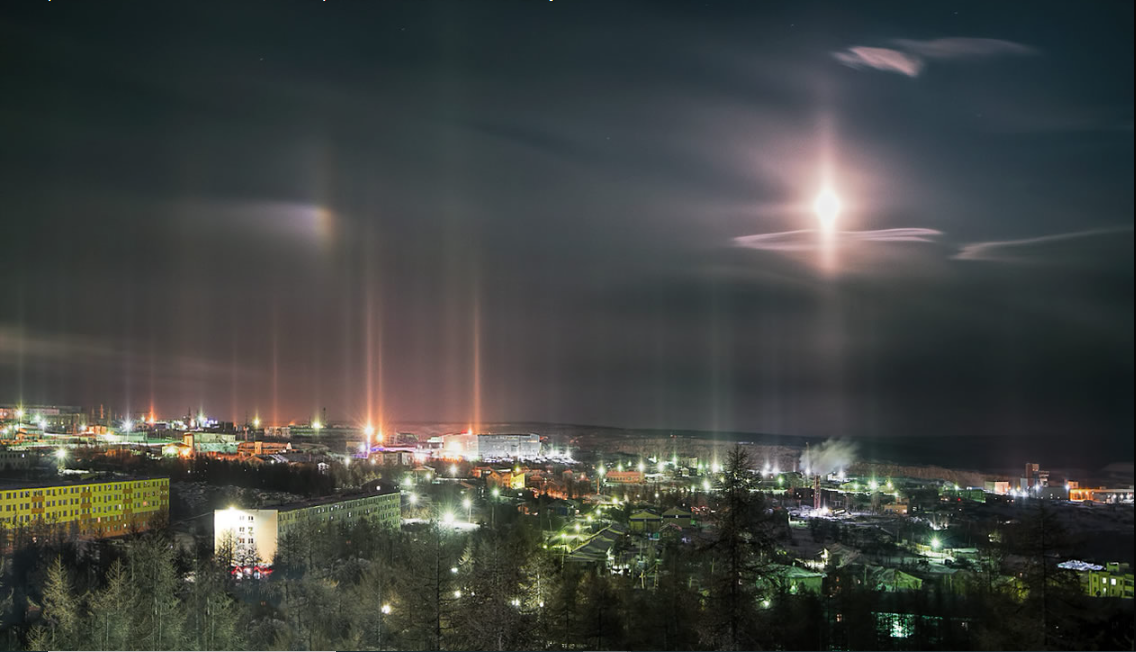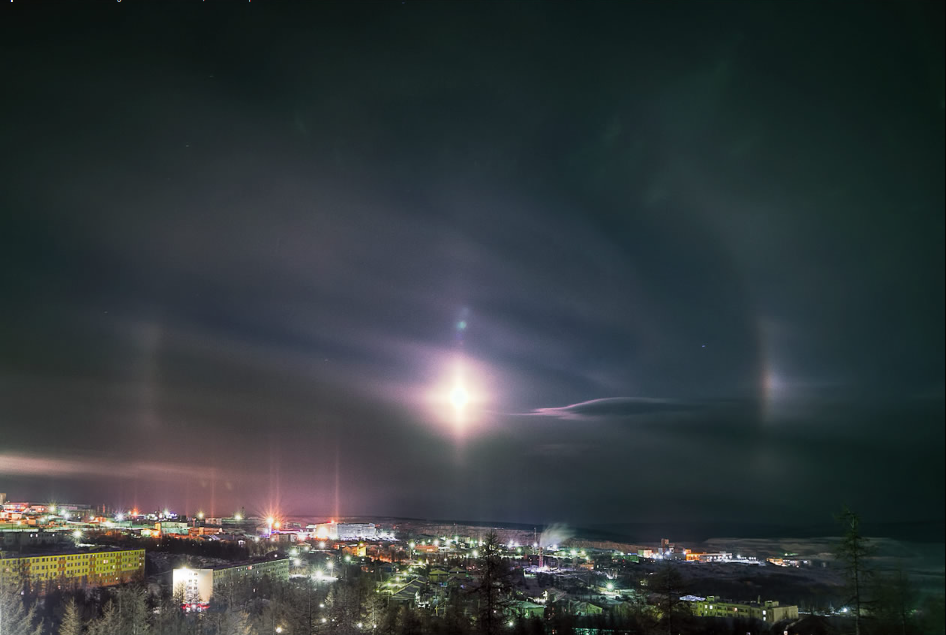Light Pillars & Moondogs, Eastern Siberia - OPOD
Light Pillars & Moondogs: A Mesmerizing Atmospheric Phenomenon in Eastern Siberia
Have you ever gazed up at the night sky and been captivated by the ethereal beauty of celestial phenomena? In the remote region of Eastern Siberia, a diamond mining center called Aykhal, Okcana Gracheva captured stunning images of two fascinating atmospheric optical phenomena: light pillars and moondogs. These mesmerizing displays are created by millions of low-level horizontal plate crystals suspended in the freezing air, reflecting ground lights and producing enchanting illusions of upward pillars of light. Additionally, these same plate crystals, possibly found in high cirrus clouds, generate moondogs, a faint 22° halo, and a hint of a parhelic circle. Let's delve deeper into these awe-inspiring atmospheric wonders and explore their captivating characteristics.
Light Pillars: Illuminating the Night Sky
Light pillars are a breathtaking spectacle that can occur in cold regions when the air is laden with tiny ice crystals. In Eastern Siberia, these crystals form flat, horizontally-oriented plates that drift through the atmosphere. As light from ground sources, such as streetlights or buildings, interacts with these crystals, it undergoes a process called reflection. The reflected light then appears as luminous columns extending vertically into the sky, creating the illusion of pillars of light. This phenomenon is especially prominent in areas with minimal light pollution, where the contrast between the dark sky and the illuminated pillars is truly mesmerizing.
Moondogs: Celestial Companions
In addition to light pillars, Okcana Gracheva's images also captured the elusive moondogs. Moondogs, also known as paraselenae or mock moons, are optical phenomena that occur alongside the moon. These captivating apparitions manifest as two bright spots of light on either side of the moon, creating a celestial trio. Moondogs are formed by the same low-level plate crystals that generate light pillars. When moonlight passes through these crystals, it is refracted and dispersed, resulting in the appearance of these fascinating companions to our lunar neighbor.
The Faint 22° Halo and Parhelic Circle: Subtle Hints of Radiance
Accompanying the light pillars and moondogs in the images from Eastern Siberia is a faint 22° halo and a hint of a parhelic circle. A 22° halo is a circular ring of light that surrounds the sun or moon at an angle of approximately 22 degrees. It is created when light interacts with hexagonal ice crystals in high cirrus clouds. Similarly, a parhelic circle is a diffuse band of light that encircles the sun at the same altitude as the 22° halo. Both of these optical phenomena add an extra layer of intrigue to the already captivating display in the Siberian night sky.
The Science Behind the Splendor
The enchanting optical phenomena observed in Eastern Siberia are a result of the interaction between light and ice crystals suspended in the atmosphere. The formation of light pillars and moondogs can be explained by the principles of reflection, refraction, and dispersion. When light encounters these ice crystals, it is either reflected or refracted, causing it to change direction or split into its component colors. This interplay between light and crystals creates the mesmerizing visual effects that we witness in the night sky.
Appreciating the Beauty of Nature's Artistry
Witnessing atmospheric optical phenomena such as light pillars, moondogs, and their accompanying halos is a reminder of the awe-inspiring beauty that surrounds us. These transient displays serve as a testament to the delicate balance between natural elements and the intricate interplay of light and matter. As we gaze up at the night sky and marvel at these enchanting spectacles, we are reminded of the boundless wonders that our universe has to offer.
In conclusion, the images captured by Okcana Gracheva in Eastern Siberia provide a glimpse into the captivating world of atmospheric optics. The mesmerizing light pillars, moondogs, and their accompanying halos serve as a testament to the breathtaking beauty that can be found in the natural world. These optical phenomena are a result of the interplay between light and ice crystals suspended in the atmosphere, creating illusions and celestial companions that leave us in awe. So, next time you find yourself beneath a starlit sky, take a moment to appreciate the enchanting displays that nature has to offer and let yourself be transported into the realm of atmospheric wonder.

Moondogs & Light Pillars, Eastern Siberia ~ Images by Okcana Gracheva at Aykhal, a diamond mining centre in Yakutia. Millions of low level horizontal plate crystals drifting in the freezing air reflect ground lights to produce the illusion of upward pillars of light. Similar plates, probably in high cirrus, generate the moondogs, a faint 22° halo and a hint of parhelic circle. All images ©Okcana Gracheva, shown with permission

Note: this article has been automatically converted from the old site and may not appear as intended. You can find the original article here.
Reference Atmospheric Optics
If you use any of the definitions, information, or data presented on Atmospheric Optics, please copy the link or reference below to properly credit us as the reference source. Thank you!
-
<a href="https://atoptics.co.uk/blog/light-pillars-moondogs-eastern-siberia-opod/">Light Pillars & Moondogs, Eastern Siberia - OPOD</a>
-
"Light Pillars & Moondogs, Eastern Siberia - OPOD". Atmospheric Optics. Accessed on November 26, 2024. https://atoptics.co.uk/blog/light-pillars-moondogs-eastern-siberia-opod/.
-
"Light Pillars & Moondogs, Eastern Siberia - OPOD". Atmospheric Optics, https://atoptics.co.uk/blog/light-pillars-moondogs-eastern-siberia-opod/. Accessed 26 November, 2024
-
Light Pillars & Moondogs, Eastern Siberia - OPOD. Atmospheric Optics. Retrieved from https://atoptics.co.uk/blog/light-pillars-moondogs-eastern-siberia-opod/.